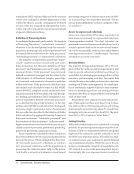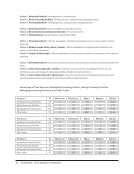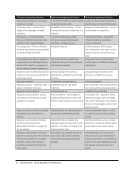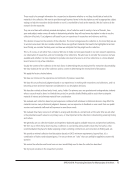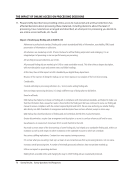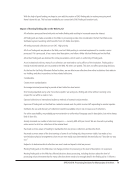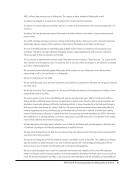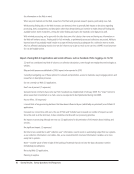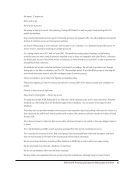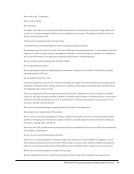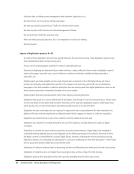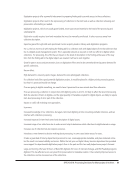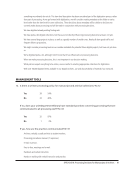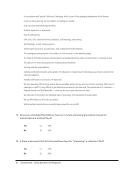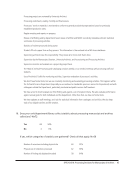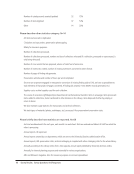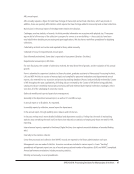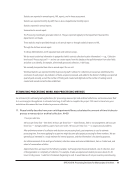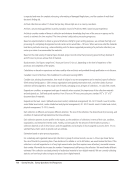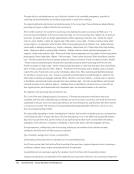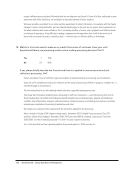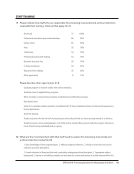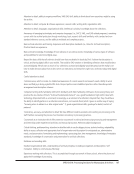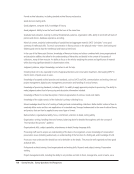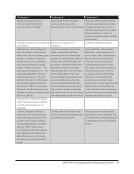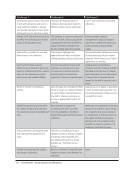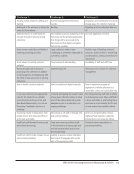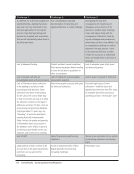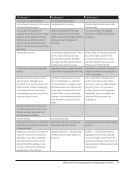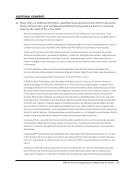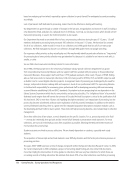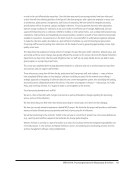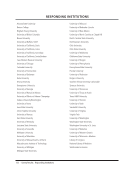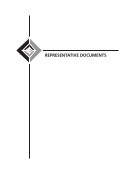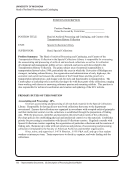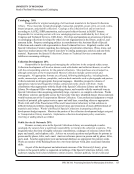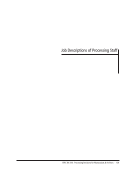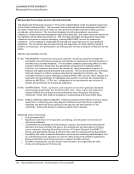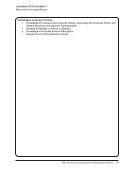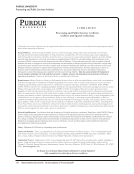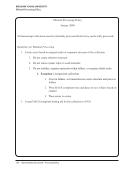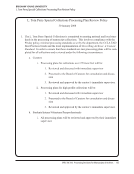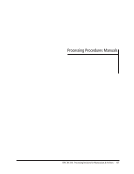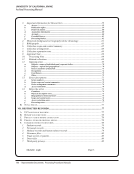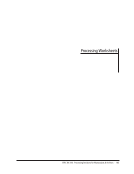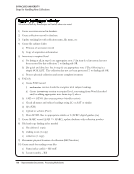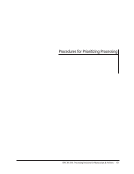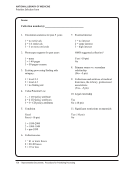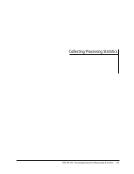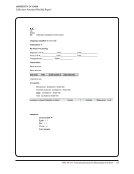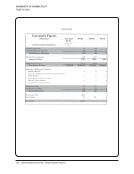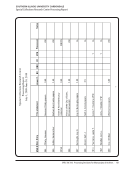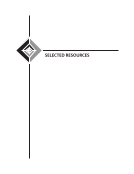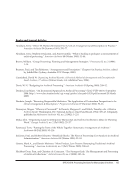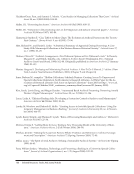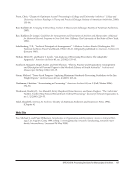SPEC Kit 314: Processing Decisions for Manuscripts &Archives · 11
were consortial/collaborative activities (29 responses
or 39%) and the digital format shelf life (20 or 26%).
Some respondents noted that the experience, special
skills, and number of staff can impact their priority
decisions.
Other factors that significantly influence process-
ing priorities include donor relations and outside
funding. One respondent reflected, “Donor agree-
ments that include processing deadlines and donor
funding for processing are important considerations
when setting processing priorities.” Another indi-
cated, “Donor expectations are sometimes considered,
if a collection if particularly important. We do try
not to make promises about when a collection will
be processed, but it sometimes comes up in certain
donor-related situations.”
More than half of the responding institutions (44
or 60%) discuss requirements for access to collections
and what materials need to be processed with their
researchers. Others discuss priorities more casually.
According to one respondent, “We do this informally
and look to support the research efforts of our patrons
whenever we can while still attaining other depart-
mental goals.”
Determining Levels of Description
“The goal should be to maximize the accessibility of
collection materials to user,” according to Greene and
Meissner. When asked which levels of description
have been used for manuscript and archival collec-
tions, all but two (71 or 97%) responded folder-level
and most (82% to 86%) also use collection-, item-, and
series-level descriptions, depending on the collec-
tion. One respondent explained, “The approach differs
based on the presumed research value of the materi-
als, on the degree of access restrictions which may
be placed on the materials, and the time available to
attain production goals.”
When considering factors to establish the level of
description for a collection or part of a collection, the
three most important are patron access needs, antici-
pated high-use, and size of collection. One respondent
who considers other factors noted that “the nature of
the collection is a major factor in determining what is
to be done.” Other comments listed the complexity of
the organization of materials within a collection and
digitization potential as other factors to be considered.
In “Accessioning as Processing,” Christine
Weidman argued that “time, budget, and personnel
constraints at academic institutions render folder-level
processing difficult if not impossible to complete for
every collection.”4 Yet when asked what factors are
used to decide to process at the folder level, the ma-
jority of respondents indicated that this would be the
ideal level for all collections. In addition, the folder
level was considered an important aspect in provid-
ing patron access.
The size of collections factors into deciding to use
series- and collection-level description, but not item
level. Nine respondents indicated that the criteria for
processing at the collection level included the size of
the collection itself. Others discussed this level as “a
temporary description, used to alert researchers to the
existence of the collection.” Criteria for determining
series levels included the complexity as well as size
of the collection. One respondent stated, “Series-level
description must suffice to provide patrons with a de-
tailed account of the series content and its relation to
the collection as a whole.” Yet factors for determining
processing to the item level were anticipated high-use,
monetary value, security, and format type. As one re-
spondent explained, “Unless it’s George Washington’s
signature on the invoice of an axe-maker, it’s folder
level.” Two respondents reported that they never pro-
cess anything at the item level.
When asked to describe how an institution deter-
mines the minimal level a researcher needs in order to
use a manuscript and archival collection, the answers
were widely varied. Many of the comments reflected
that “the primary factor is size and uniformity—what
is the lowest level at which we can convey the con-
tents and the size allows a reasonable expectation
that the researcher will be able to locate a specific
item or group of materials without further guidance
or description.”
Impact of Online Access on Processing Decisions
Almost all respondents (59 or 89%) are marking up
finding aids in Encoded Archival Description (EAD).
When describing how encoding finding aids in EAD
were consortial/collaborative activities (29 responses
or 39%) and the digital format shelf life (20 or 26%).
Some respondents noted that the experience, special
skills, and number of staff can impact their priority
decisions.
Other factors that significantly influence process-
ing priorities include donor relations and outside
funding. One respondent reflected, “Donor agree-
ments that include processing deadlines and donor
funding for processing are important considerations
when setting processing priorities.” Another indi-
cated, “Donor expectations are sometimes considered,
if a collection if particularly important. We do try
not to make promises about when a collection will
be processed, but it sometimes comes up in certain
donor-related situations.”
More than half of the responding institutions (44
or 60%) discuss requirements for access to collections
and what materials need to be processed with their
researchers. Others discuss priorities more casually.
According to one respondent, “We do this informally
and look to support the research efforts of our patrons
whenever we can while still attaining other depart-
mental goals.”
Determining Levels of Description
“The goal should be to maximize the accessibility of
collection materials to user,” according to Greene and
Meissner. When asked which levels of description
have been used for manuscript and archival collec-
tions, all but two (71 or 97%) responded folder-level
and most (82% to 86%) also use collection-, item-, and
series-level descriptions, depending on the collec-
tion. One respondent explained, “The approach differs
based on the presumed research value of the materi-
als, on the degree of access restrictions which may
be placed on the materials, and the time available to
attain production goals.”
When considering factors to establish the level of
description for a collection or part of a collection, the
three most important are patron access needs, antici-
pated high-use, and size of collection. One respondent
who considers other factors noted that “the nature of
the collection is a major factor in determining what is
to be done.” Other comments listed the complexity of
the organization of materials within a collection and
digitization potential as other factors to be considered.
In “Accessioning as Processing,” Christine
Weidman argued that “time, budget, and personnel
constraints at academic institutions render folder-level
processing difficult if not impossible to complete for
every collection.”4 Yet when asked what factors are
used to decide to process at the folder level, the ma-
jority of respondents indicated that this would be the
ideal level for all collections. In addition, the folder
level was considered an important aspect in provid-
ing patron access.
The size of collections factors into deciding to use
series- and collection-level description, but not item
level. Nine respondents indicated that the criteria for
processing at the collection level included the size of
the collection itself. Others discussed this level as “a
temporary description, used to alert researchers to the
existence of the collection.” Criteria for determining
series levels included the complexity as well as size
of the collection. One respondent stated, “Series-level
description must suffice to provide patrons with a de-
tailed account of the series content and its relation to
the collection as a whole.” Yet factors for determining
processing to the item level were anticipated high-use,
monetary value, security, and format type. As one re-
spondent explained, “Unless it’s George Washington’s
signature on the invoice of an axe-maker, it’s folder
level.” Two respondents reported that they never pro-
cess anything at the item level.
When asked to describe how an institution deter-
mines the minimal level a researcher needs in order to
use a manuscript and archival collection, the answers
were widely varied. Many of the comments reflected
that “the primary factor is size and uniformity—what
is the lowest level at which we can convey the con-
tents and the size allows a reasonable expectation
that the researcher will be able to locate a specific
item or group of materials without further guidance
or description.”
Impact of Online Access on Processing Decisions
Almost all respondents (59 or 89%) are marking up
finding aids in Encoded Archival Description (EAD).
When describing how encoding finding aids in EAD












